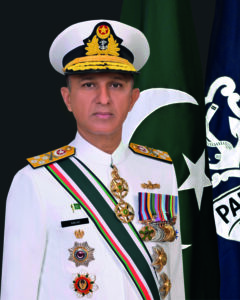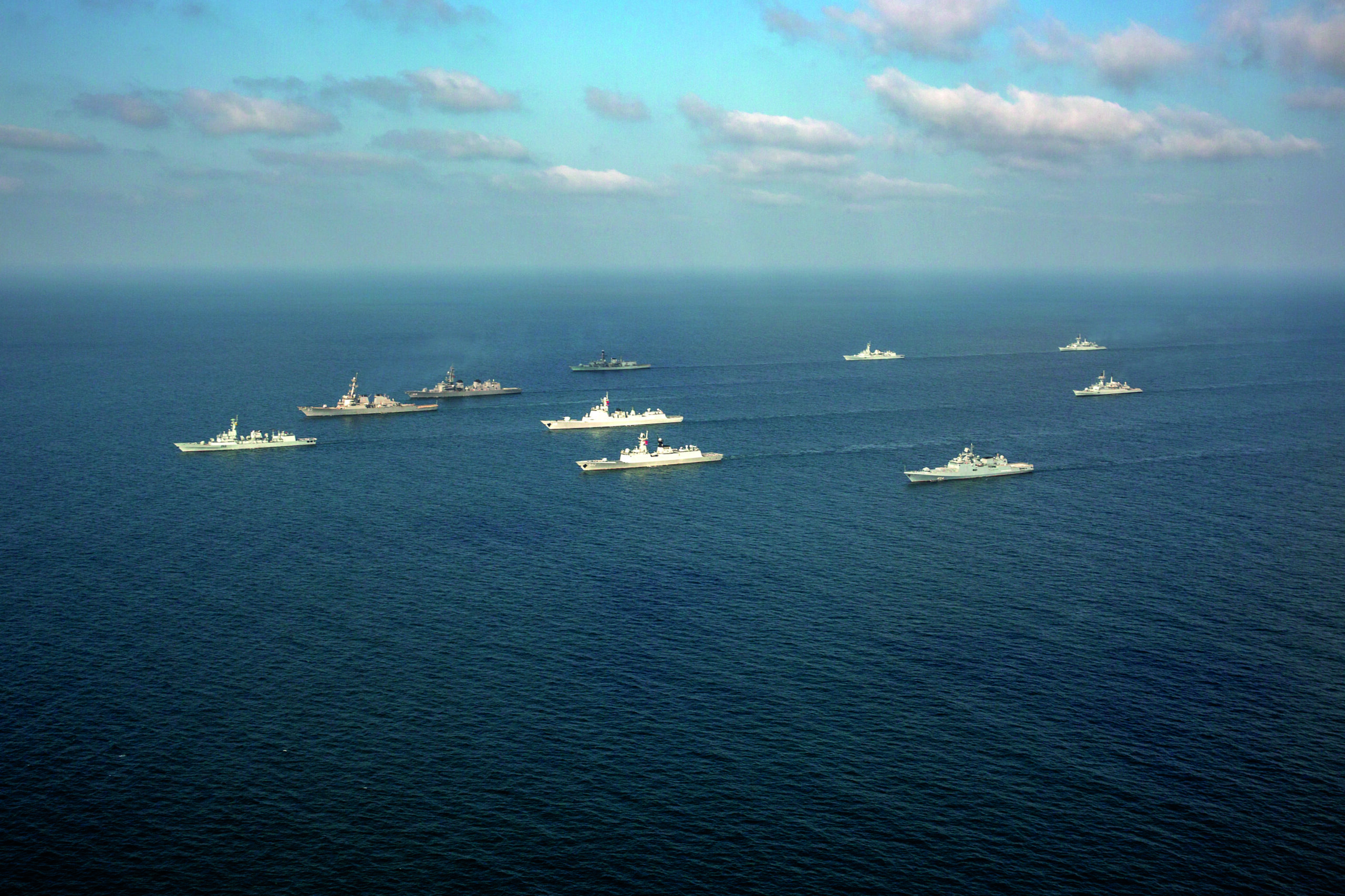In an interview with MDM, Admiral Muhammad Amjad Khan Niazi, Chief of Naval Staff, Pakistan Navy, outlines how his force is stepping up efforts to modernise its inventory in order to continue to cope with the challenges of meeting operational requirements. At the same time, as the biggest stumbling block, the conundrum of finding cost-effective solutions needs to be circumnavigated. Adm. Niazi explains how the Pakistan Navy is looking for ‘good enough’ yet ‘affordable’ solutions. In this interview with MDM he also points out that the appropriate course of action for the Pakistan Navy is to gain self-reliance in developing capable naval platforms.

Admiral Muhammad Amjad Khan Niazi NI(M) S Bt. has been Chief of Naval Staff of the Pakistan Navy since 7 October 2020. His previous appointments include command of two Type 21 ships, Commandant PNS Bahadur (the largest training establishment of Pakistan Navy), Director Naval Operations at Naval Headquarters and Commander Pakistan Fleet. He has also served as Commander 18th Destroyer Squadron, Commandant of the Pakistan Navy War College, Lahore, and Director General Naval Intelligence.
MDM: During recent years, the Pakistan Navy has been experiencing a significant rejuvenation. Could you update our readers on its status?
Admiral Niazi: With evolving traditional and non-traditional threat dynamics, the induction of new platforms and the modernisation of existing assets has become an imperative for the Pakistan Navy. Accordingly, Type 054-A/P frigates from China, ‘Milgem’ class corvettes from Turkey and OPVs from Damen Shipyards, Romania, were contracted to augment the surface fleet. Two ships of Tughril class, frigates of Type 054-A/P and equipped with state-of-the-art weapons and sensors, have been commissioned. Two Yarmook class OPVs have also been inducted to fulfil our maritime security requirements. Indigenously, we have built the largest fleet tanker, PNS Moawin, at Karachi Shipyard & Engineering Works (KS&EW) in collaboration with Turkey to enhance our logistics capabilities. Fast attack craft (missile) equipped with cruise missiles are also being inducted gradually through indigenous construction. This has given significant boost to our ship building capabilities.
In the sub-surface domain, we are focusing on modernising our existing submarine force through a mid-life upgrade programme for the ‘Agosta 90B’ submarines. This is currently underway in collaboration with Turkey. Furthermore, eight Hangor class submarines with an air independent propulsion (AIP) system are under various stages of construction in China and in Pakistan. In naval aviation, we are operating Sea King helicopters, CH-4 MALE UCAVs and ‘marinised’ ATR aircraft to enhance our maritime domain awareness and our capabilities in airborne anti-surface warfare. The Pakistan Navy has also acquired jet-powered maritime patrol aircraft for high-speed surveillance and deep-sea strike capabilities. They are currently undergoing a modernisation.
In short, the Pakistan Navy is being transformed into a modern and balanced fleet suitably configured to deal with emerging threats and challenges in the maritime domain.
MDM: Western experts have reported that additional Chinese and Turkish designed naval assets are to be delivered to your navy but will be built in Pakistan. Could you share more insights?
Admiral Niazi: Our strategy with regard to new inductions is to collaborate with foreign construction yards and exploit their experience as well as their expertise to enhance our own ship building capabilities gradually. Transfer of technology is thus included in the contracts. Two ‘Milgem’ class corvettes are being constructed at KS&EW. Furthermore, four Hangor class submarines are also being constructed in collaboration with China. Indigenous construction of new platforms is enabling capability enhancement at KS&EW in terms both of human resources and also its capacity to construct an expanded variety of platforms.
The successful manifestation of this approach is evident through the commissioning of PNS Haibat in March 2022. This fast attack craft (missile) will be our first ever completely ‘Made in Pakistan’ vessel of the type in terms of design and construction. It has evolved after gaining experience from the earlier construction of three similar vessels at KS&EW. The focus of these efforts is to acquire new capabilities in line with our operational requirements while gradually enhancing our ship building capabilities to achieve self-reliance.

MDM: What about future procurement?
Admiral Niazi: My Vision of the Pakistan Navy’s development is based on ‘progressive capability enhancement’. In addition to those projects I have already expounded, two larger and more capable OPVs from Damen Shipyards are presently under construction in Romania. We are also developing frigates. The ‘Jinnah’ class (‘Jinnah’ class frigates, JCFs) will be based on our experience of building ‘Milgem’ class corvettes with Turkey. The design is in final stages and its construction will be undertaken at KS&EW. Thus, JCFs will be our first frigate-sized warships locally designed and constructed. With this project, I envisage a substantial boost to Pakistan’s domestic ship building capability to meet our future needs.
We are also constructing indigenously designed gunboats at KS&EW to gain experience in ship construction and induct low-cost platforms into the Pakistan Navy. In the next 10-15 years, our focus is to present modern platforms and force-multipliers by expanding our indigenous capability and where appropriate, through collaboration with foreign OEMs. Development of naval systems is also being undertaken by our research and development (R&D) organisations.
In short, our aim is to modernise our fleet and transform it into a balanced, effective, and combat ready force while remaining within the budgetary constraints.
MDM: In your submarine flotilla, one sees a mix of Chinese and French constructions. What are the challenges with respect to logistics and training? And how do you cope with them?
Admiral Niazi: The Pakistan Navy has always looked to maintain an offensive sub-surface capability through indigenous development in collaboration with foreign naval yards. You may be aware that the third submarine of the ‘Agosta 90B’ series was constructed in Pakistan through a transfer of technology granted by France. She was commissioned in the Pakistan Navy in 2006. The expertise gained during this ‘home-made’ construction of an ‘Agosta 90B’ submarine helped us significantly in maintaining and operating these submarines. Following the same trend, a prominent feature of the Hangor class submarine project is the transfer of technology. Four submarines are being constructed in Pakistan.
This will be a valuable experience and a significant capability enhancement that will enable us to operate and maintain Hangor class submarines effectively, as has been the case with the Agosta class submarines. I would agree that having a submarine force which is a mix of two different technologies can be challenging in terms of logistics and training. However, given restrictions and the high cost of modern military technology, naval forces – especially in developing countries – are compelled to look for economic and cost-effective solutions to meet their security needs. The Pakistan Navy is no exception. Therefore, whilst remaining within the confines of our budgetary allocations, we endeavour to find ‘good enough’ yet ‘affordable’ solutions, at the same time aligning our logistics and training setups in collaboration with the relevant OEMs.
MDM: Likewise, your surface combatants will be a mix of Chinese, Dutch and Turkish designs. Their inherently diverse design conceptions, as well as different supply chains, will stress logistics and training. What answers has the Pakistan Navy found in order to manage the associated challenges?
Admiral Niazi: As I already mentioned, naval forces – especially in the developing countries – operate in a resource-constrained environment and have to look for cost-effective solutions to meet their security needs. In Pakistan, we have modest in-country facilities to build modern naval platforms and systems. We are therefore, modernising our fleet by diversifying our collaboration with foreign OEMs, thereby mitigating our external dependencies and progressively strengthening our indigenous capabilities. In this regard, the Pakistan Navy already has extensive experience of operating surface combatants with diverse Western and Chinese technologies. Our training arrangements as well as our logistics infrastructure is geared towards dealing with this configuration. Furthermore, during the construction of new platforms, our teams liaise with the OEMs to streamline logistical and technical aspects. This is mainly achieved through the development of integrated logistics support packages as part of the contractual scheme for through-life-sustainment. The aim is to make best use of our available resources and modest industrial base to maintain and operate Pakistan Navy platforms effectively.

MDM: Admiral, you may understand that in our part of the world there are a lot of questions concerning a potential nuclear-armed submarine for the Pakistan Navy. Could you unveil the cover of secrecy a little?
Admiral Niazi: The Pakistan Navy currently operates Agosta class conventional submarines, which are armed with anti-ship/land-attack missiles and heavy weight torpedoes. These submarines are primarily employed for anti-surface and anti-submarine roles. Our future Hangor class submarines that are being acquired from China are also conventional submarines. Although it is my personal desire that the Pakistan Navy should have a nuclear submarine to restore the growing strategic imbalance in our neighbourhood due to the development and acquisition of nuclear submarines elsewhere, this decision will be taken at the national, political level.
MDM: A question about the progress in transitioning towards local construction at KS&EW. Could you please give an insight of what is the current status quo, and which new projects are envisaged?
Admiral Niazi: As I already mentioned, strengthening the indigenous capabilities of KS&EW in collaboration with friendly countries has remained my primary focus. In this regard, valuable experience gained during the construction of Azmat class fast attack craft (missile) through transfer of technology enabled us to achieve the milestone of commissioning an indigenously designed and locally built vessel, PNS Haibat. Currently, we are building upon the same experience with respect to an indigenously designed gunboat. Thus, we further develop our local industry and improve the shipbuilding skills of our workforce at KS&EW. We intend to capitalise on our on-going experience of building ‘Milgem’ class corvettes, which will lead to the construction of the JCFs at KS&EW. Building four Hangor class submarines at KS&EW will also provide a significant capability enhancement. Our aim is to achieve self-reliance in developing capable naval platforms to meet our operational requirements, in line with contemporary maritime environmental standards.

MDM: Finally, concerning your co-operation with European and Asian Navies, what are the intentions for 2023 and the longer term?
Admiral Niazi: In line with our national policy of co-existence and peaceful relations within the region and beyond, the Pakistan Navy has been actively pursuing naval diplomacy in different parts of the world. Our efforts include participation in regional and international efforts for maintaining good order at sea, participation in bilateral as well as in multilateral exercises, overseas deployments, humanitarian assistance and disaster relief missions, and undertaking non-combatant evacuation operations of stranded individuals from conflict zones. Our contributions to Combined Task Force 150 (CTF 150) since 2004 and Combined Task Force 151 (CTF 151) since 2009, under the ambit of Combined Maritime Forces (CMF), are well known and recognised at international level.
The Pakistan Navy also engages with friendly countries through collaborative defence forums, key leadership engagements and navy-to-navy expert level staff talks (ELSTs). We have formally established navy-to-navy ELSTs mechanisms with 21 Navies across the world, including navies from Europe and Asia. Our objective is to pursue bilateral collaboration in a structured manner and to advance collaboration covering operational, training, and technical aspects. The Pakistan Navy will also continue to avail itself of courses offered by European countries for training our officers and personnel. The Pakistan Navy is a member of the Indian Ocean Naval Symposium and an observer in the Western Pacific Naval Symposium. In future, the Pakistan Navy intends to continue playing an active role in collaborative maritime security constructs in the region and strengthen naval cooperation with regional and international navies.
MDM: Admiral Niazi, thank you very much for your informative and comprehensive answers.
MDM’s questions were asked by Hans Uwe Mergener.






